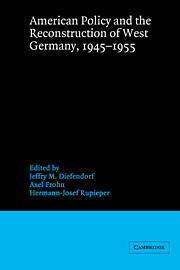Book contents
- Frontmatter
- 1 “Ripping Holes in the Iron Curtain”: The Council on Foreign Relations and Germany, 1945–1950
- 2 U.S. Policy on a West German Constitution, 1947-1949
- 3 American Policy toward German Unification, 1949-1955
- 4 Marshall Plan and Currency Reform
- 5 American Policy toward Germany and the Integration of Europe, 1945-1955
- 6 From Morgenthau Plan to Schuman Plan: America and the Organization of Europe
- 7 Return to Normality: The United States and Ruhr Industry, 1949-1955
- 8 West German Agriculture and the European Recovery Program, 1948-1952
- 9 Science, Technology, and Reparations in Postwar Germany
- 10 American Deconcentration Policy in the Ruhr Coal Industry
- 11 Technology Transfer and the Emergence of the West German Petrochemical Industry, 1945-1955
- 12 The Free University of Berlin: A German Experiment in Higher Education, 1948–1961
- 13 HICOG and the Unions in West Germany: A Study of HICOG’s Labor Policy toward the Deutscher Gewerkschaftsbund, 1949–1952
- 14 U.S. Military Occupation, Grass Roots Democracy, and Local German Government
- 15 German Democratization as Conservative Restabilization: The Impact of American Policy
- 16 America and the Rebuilding of Urban Germany
- 17 U.S. Policy toward German Veterans, 1945-1950
- 18 Grand Illusions: The United States, the Federal Republic of Germany, and the European Defense Community, 1950-1954
- 19 The Federal Republic of Germany as a “Battlefield” in American Nuclear Strategy, 1953-19
- 20 The Presence of American Troops in Germany and German-American Relations, 1949-1956
- 21 John J. McCloy and the Landsberg Cases
- 22 Sources in German Archives on the History of American Policy toward Germany, 1945-1955
- 23 U.S. High Commissioner for Germany and Related Records: Sources for the History of the Federal Republic of Germany, 1949–1955, in the U.S. National Archives and Records Administration
- Bibliography
- Index
6 - From Morgenthau Plan to Schuman Plan: America and the Organization of Europe
Published online by Cambridge University Press: 05 January 2013
- Frontmatter
- 1 “Ripping Holes in the Iron Curtain”: The Council on Foreign Relations and Germany, 1945–1950
- 2 U.S. Policy on a West German Constitution, 1947-1949
- 3 American Policy toward German Unification, 1949-1955
- 4 Marshall Plan and Currency Reform
- 5 American Policy toward Germany and the Integration of Europe, 1945-1955
- 6 From Morgenthau Plan to Schuman Plan: America and the Organization of Europe
- 7 Return to Normality: The United States and Ruhr Industry, 1949-1955
- 8 West German Agriculture and the European Recovery Program, 1948-1952
- 9 Science, Technology, and Reparations in Postwar Germany
- 10 American Deconcentration Policy in the Ruhr Coal Industry
- 11 Technology Transfer and the Emergence of the West German Petrochemical Industry, 1945-1955
- 12 The Free University of Berlin: A German Experiment in Higher Education, 1948–1961
- 13 HICOG and the Unions in West Germany: A Study of HICOG’s Labor Policy toward the Deutscher Gewerkschaftsbund, 1949–1952
- 14 U.S. Military Occupation, Grass Roots Democracy, and Local German Government
- 15 German Democratization as Conservative Restabilization: The Impact of American Policy
- 16 America and the Rebuilding of Urban Germany
- 17 U.S. Policy toward German Veterans, 1945-1950
- 18 Grand Illusions: The United States, the Federal Republic of Germany, and the European Defense Community, 1950-1954
- 19 The Federal Republic of Germany as a “Battlefield” in American Nuclear Strategy, 1953-19
- 20 The Presence of American Troops in Germany and German-American Relations, 1949-1956
- 21 John J. McCloy and the Landsberg Cases
- 22 Sources in German Archives on the History of American Policy toward Germany, 1945-1955
- 23 U.S. High Commissioner for Germany and Related Records: Sources for the History of the Federal Republic of Germany, 1949–1955, in the U.S. National Archives and Records Administration
- Bibliography
- Index
Summary
To travel from the Morgenthau Plan to the Schuman Plan is to move from an American proposal to destroy Ruhr industry to the actual organization of Europe around it only five years later and to cross from the threshold of the short, unhappy period of postwar reconstruction into the far longer and better era of sustained growth and improved public welfare that continues uninterrupted into the present. This transformation required the maturation of American foreign policy. The United States wanted to withdraw from Europe after the defeat of Hitler. Roosevelt's Grand Design for the postwar world did not break cleanly with traditional isolationism. Based on the supposition that a framework of peace could be built upon the two principles of self-determination and free trade, it limited U.S. interventions to policing actions conducted jointly with the other Allied nations, especially the Soviet Union. As a reconstruction strategy, the Grand Design was worthless and as a guide to action meaningless; it would indeed remain only a big sketch.
United States policy-making after World War II developed in response to successive international crises, cropping up as a result of economic and political dislocation, shifts in the strategic balance, mutual hostility, miscalculation, and incompetence. Unguided by overall strategy, America's reconstruction policy in Europe, particularly as it affected the occupied former Reich, became the plaything of domestic factions.
- Type
- Chapter
- Information
- Publisher: Cambridge University PressPrint publication year: 1994
- 1
- Cited by

